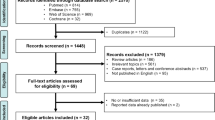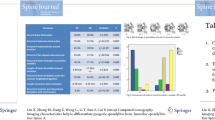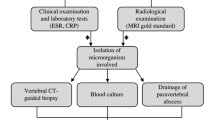Abstract
Objectives
To develop and evaluate a logistics regression diagnostic model based on computer tomography (CT) features to differentiate tuberculous spondylitis (TS) from pyogenic spondylitis (PS).
Methods
Demographic and clinical features were collected from the Electronic Medical Record System. Data of bony changes seen on CT images were compared between the PS (n = 61) and TS (n = 51) groups using the chi-squared test or t test. Based on features that were identified to be significant, a diagnostic model was developed from a derivation set (two thirds) and evaluated in a validation set (one third). The sensitivity, specificity, and area under the receiver operating characteristic curve (AUC) were calculated.
Results
The width of bone formation around the vertebra and sequestrum was greater in the TS group. There were significant differences between the two groups in the horizontal and longitudinal location of erosion and the morphology of axial bone destruction and sagittal residual vertebra. Kyphotic deformity and overlapping vertebrae were more common in the TS group. A diagnostic model that included eight predictors was developed and simplified to include the following six predictors: width of the bone formation surrounding the vertebra, longitudinal location, axial-specific erosive morphology, specific morphology of the residual vertebra, kyphotic deformity, and overlapping vertebrae. The simplified model showed good sensitivity, specificity, and total accuracy (85.59%, 87.80%, and 86.50%, respectively); the AUC was 0.95, indicating good clinical predictive ability.
Conclusions
A diagnostic model based on bone destruction and formation seen on CT images can facilitate clinical differentiation of TS from PS.
Key Points
• We have developed and validated a simple diagnostic model based on bone destruction and formation observed on CT images that can differentiate tuberculous spondylitis from pyogenic spondylitis.
• The model includes six predictors: width of the bone formation surrounding the vertebra, longitudinal location, axial-specific erosive morphology, specific morphology of the residual vertebra, kyphotic deformity, and overlapping vertebrae.
• The simplified model has good sensitivity, specificity, and total accuracy with a high AUC, indicating excellent predictive ability.






Similar content being viewed by others
Abbreviations
- AUC:
-
Area under the receiver operating characteristic curve
- CT:
-
Computed tomography
- NPV:
-
Negative predictive value
- PPV:
-
Positive predictive value
- PS:
-
Pyogenic spondylitis
- TS:
-
Tuberculous spondylitis
References
Kourbeti IS, Tsiodras S, Boumpas DT (2008) Spinal infections: evolving concepts. Curr Opin Rheumatol 20:471–479
Hopkinson N, Patel K (2016) Clinical features of septic discitis in the UK: a retrospective case ascertainment study and review of management recommendations. Rheumatol Int 36:1319–1326
Glaziou P, Floyd K, Raviglione MC (2018) Global epidemiology of tuberculosis. Semin Respir Crit Care Med 39:271–285
MacNeil A, Glaziou P, Sismanidis C, Maloney S, Floyd K (2019) Global epidemiology of tuberculosis and progress toward achieving global targets - 2017. MMWR Morb Mortal Wkly Rep 68:263–266
Jia CG, Gao JG, Liu FS et al (2020) Efficacy, safety and prognosis of treating neurological deficits caused by spinal tuberculosis within 4 weeks’ standard anti-tuberculosis treatment: a single medical center’s experience. Exp Ther Med 19:519–526
Rajasekaran S, Soundararajan DCR, Shetty AP, Kanna RM (2018) Spinal tuberculosis: current concepts. Global Spine J 8:96S–108S
Sheikh AF, Khosravi AD, Goodarzi H et al (2017) Pathogen identification in suspected cases of pyogenic spondylodiscitis. Front Cell Infect Microbiol 7:60
Jeong S, Choi S, Youm J, Kim H, Ha H, Yi J (2014) Microbiology and epidemiology of infectious spinal disease. J Korean Neurosurg Soc 56:21–27
Patel J, Upadhyay M, Kundnani V, Merchant Z, Jain S, Kire N (2020) Diagnostic efficacy, sensitivity, and specificity of Xpert MTB/RIF assay for spinal tuberculosis and rifampicin resistance. Spine (Phila Pa 1976) 45:163–169
Govender S (2005) Spinal infections. J Bone Joint Surg Br 87:1454–1458
Foreman SC, Schwaiger BJ, Meyer B et al (2017) Computed tomography and magnetic resonance imaging parameters associated with poor clinical outcome in spondylodiscitis. World Neurosurg 104:919–926
Liu X, Rui M, Lyu L (2019) Tuberculous meningomyelitis in magnetic resonance imaging: a Chinese case report. Eur J Radiol Open 6:284–286
Li T, Li W, Du Y et al (2018) Discrimination of pyogenic spondylitis from brucellar spondylitis on MRI. Medicine 97:e11195
Raghavan M, Lazzeri E, Palestro CJ (2018) Imaging of spondylodiscitis. Semin Nucl Med 48:131–147
Kumaran SP, Thippeswamy PB, Reddy BN, Neelakantan S, Viswamitra S (2019) An institutional review of tuberculosis spine mimics on MR imaging: cases of mistaken identity. Neurol India 67:1408–1418
Gao M, Sun J, Jiang Z et al (2017) Comparison of tuberculous and brucellar spondylitis on magnetic resonance images. Spine (Phila Pa 1976) 42:113–121
Zhang N, Zeng X, He L et al (2019) The value of MR imaging in comparative analysis of spinal infection in adults: pyogenic versus tuberculous. World Neurosurg 128:e806–e813
Berg L, Thoresen H, Neckelmann G, Furunes H, Hellum C, Espeland A (2019) Facet arthropathy evaluation: CT or MRI? Eur Radiol 29:4990–4998
Muehlematter UJ, Mannil M, Becker AS et al (2019) Vertebral body insufficiency fractures: detection of vertebrae at risk on standard CT images using texture analysis and machine learning. Eur Radiol 29:2207–2217
Liu X, Zheng M, Jiang Z, et al. (2020) Computed tomography imaging characteristics help to differentiate pyogenic spondylitis from brucellar spondylitis. Eur Spine J 29:1490–1498
Gouliouris T, Aliyu SH, Brown NM (2010) Spondylodiscitis: update on diagnosis and management. J Antimicrob Chemother 65:i11–i24
Pigrau-Serrallach C, Rodríguez-Pardo D (2013) Bone and joint tuberculosis. Eur Spine J 22(Suppl 4):556–566
Ozaksoy D, Yucesoy K, Yucesoy M, Kovanlikaya I, Yuce A, Naderi S (2001) Brucellar spondylitis: MRI findings. Eur Spine J 10:529–533
Khanna K, Sabharwal S (2019) Spinal tuberculosis: a comprehensive review for the modern spine surgeon. Spine J 19:1858–1870
Pola E, Taccari F, Autore G et al (2018) Multidisciplinary management of pyogenic spondylodiscitis: epidemiological and clinical features, prognostic factors and long-term outcomes in 207 patients. Eur Spine J 27:229–236
Jennin F, Bousson V, Parlier C, Jomaah N, Khanine V, Laredo J (2011) Bony sequestrum: a radiologic review. Skeletal Radiol 40:963–975
Shikhare SN, Singh DR, Shimpi TR, Peh WCG (2011) Tuberculous osteomyelitis and spondylodiscitis. Semin Musculoskelet Radiol 15:446–458
Wang LW, Lin H, Xin L et al (2019) Establishing a model to measure and predict the quality of gastrointestinal endoscopy. World J Gastroenterol 25:1024–1030
Yang Z, Feng L, Huang Y, Xia N (2019) A differential diagnosis model for diabetic nephropathy and non-diabetic renal disease in patients with type 2 diabetes complicated with chronic kidney disease. Diabetes Metab Syndr Obes 12:1963–1972
Acknowledgements
We sincerely express our gratitude to Meng Gao for data acquisition.
Funding
The authors state that this work has not received any funding.
Author information
Authors and Affiliations
Corresponding author
Ethics declarations
Guarantor
The scientific guarantor of this publication is Xingang Cui.
Conflict of interest
The authors of this manuscript declare no relationships with any companies whose products or services may be related to the subject matter of the article.
Statistics and biometry
No complex statistical methods were necessary for this paper.
Informed consent
Informed consent was obtained from all participants
Ethical approval
Institutional Review Board approval was obtained.
Study subjects or cohorts overlap
Some subjects or cohorts have been previously reported in journal articles (Eur Spine J; 29: 1490-1498; Spine (Phila Pa 1976); 42: 113-121).
Methodology
• retrospective
• diagnostic or prognostic study
• performed at one institution
Additional information
Publisher’s note
Springer Nature remains neutral with regard to jurisdictional claims in published maps and institutional affiliations.
Rights and permissions
About this article
Cite this article
Liu, X., Zheng, M., Sun, J. et al. A diagnostic model for differentiating tuberculous spondylitis from pyogenic spondylitis on computed tomography images. Eur Radiol 31, 7626–7636 (2021). https://doi.org/10.1007/s00330-021-07812-1
Received:
Revised:
Accepted:
Published:
Issue Date:
DOI: https://doi.org/10.1007/s00330-021-07812-1




